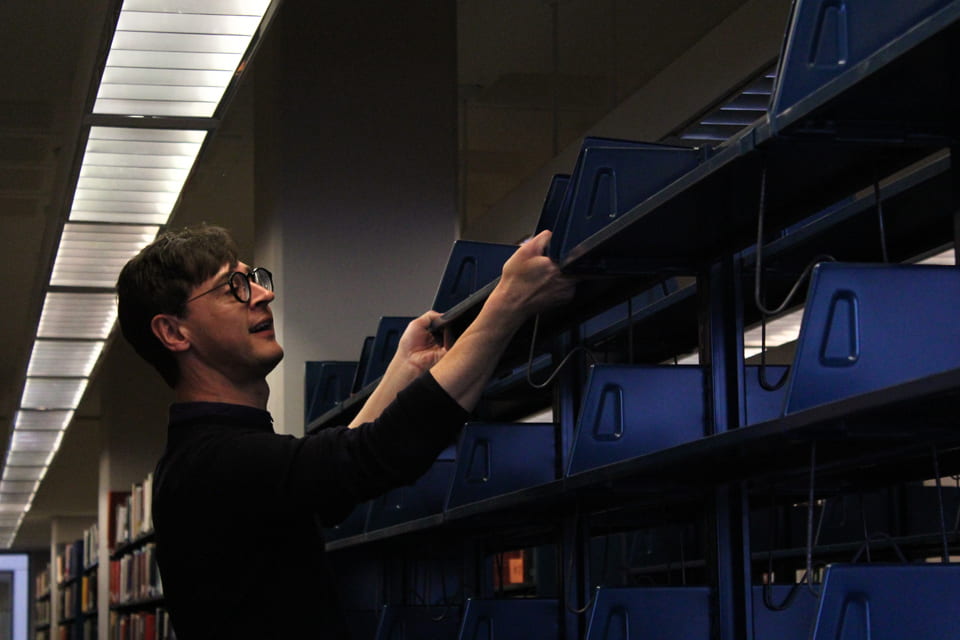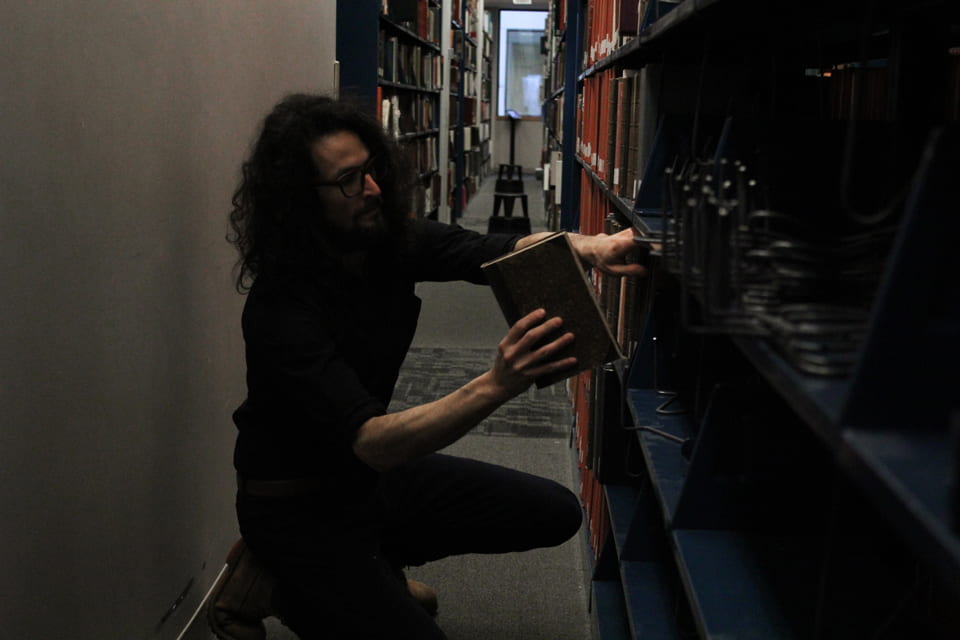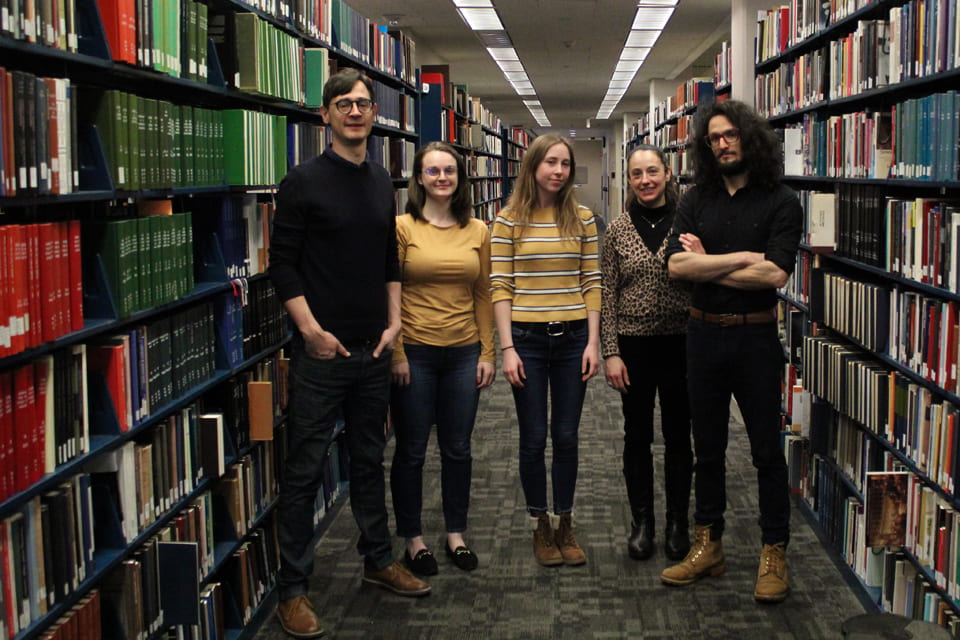If you’ve been on O’Neill Library’s 4th or 5th floors lately, you might have noticed a few things out of place. Or a few thousand things.

Can’t find a book? Until the shifting projects are finished later this year, follow the temporary call number ranges on the ends of the shelving units. (Also note: for now, the usually helpful shelf number provided by the catalog’s “locate” function may be inaccurate.)
Staff at O’Neill Library are working on two major projects to shift books in the collection, both to open space on the fifth floor for study areas, and to reduce the density of books to allow for more acquisitions. The empty ranges of shelves are temporary. On the fourth floor a dozen paces from the stairwell, the empty shelves mark one front in the library’s battle against overcrowding. The project on that floor has paused for several months to allow work on a more pressing front: space on the fifth floor needs to be cleared in time for construction crews arriving after this semester’s exam period.

“It’s an aggressive schedule,” said Rodrigo Castro, Head of Access Services, “But we’ll have it done.” He was standing in the stacks in his shifting project attire–jeans and sweatshirt–ready for several hours of moving heavy bound volumes of periodicals.
The projects began in 2018 with a concern that several areas in the collection had reached capacity: there was no way to add new volumes in fast-growing subjects without major rearranging. As Mr. Castro and his staff embarked on an inventory and heat-map of shelf density, another wrinkle was added: plans to add study space on the fifth floor. So, in addition to reducing O’Neill’s open stacks collection from 84% to 75% capacity to allow for new acquisitions, they would need to clear a space on the 5th floor occupied by 132 shelf-ranges holding 25,000 volumes. (That’s 1056 shelves, or about 1 kilometer of shelf space.) In all, 250-300,000 volumes would need to be moved to O’Neill’s high-density storage area, known to library staff by its room number: 150.
All by itself, that’s a big task, which involves first identifying volumes that haven’t circulated for 30 years and works duplicated by other print holdings or new electronic holdings. But there was an added challenge. “150 was basically full,” said Paul Bridden, Manager of Circulation & Collection Maintenance Services.

Mr. Castro is philosophical about the project. “Patrons don’t realize it, but library collections are in constant motion,” he said. “This kind of thing is happening all the time, but on a smaller scale. This job is big, so it’s impacting our users’ ability to locate items. We’re trying to minimize that impact by making sure their access to materials is never interrupted. Anything we transfer will be housed onsite, in 150, and can be retrieved in a matter of minutes when necessary.”
The fourth floor shifting project began in the summer of 2019. The fifth floor project began in January 2020. Nine staff members (including Mr. Castro and Mr. Bridden) work a combined 60-70 hours per week on the project. Between 8:00am and 9:00pm Monday through Friday, at least one staff member is either condensing books on the 5th floor, moving them to the staging area of empty shelves on the fourth floor to be moved later to processing on the second (and then to 150), or packing up long-unused books in 150 to be shipped to an offsite storage facility in Danvers, Massachusetts.
“It’s like a real-time version of Tetris,” said Nicole Kubishta, Evening Access Services Assistant. Mr. Bridden had his own metaphor: “It’s like a giant bike chain. If one link stops, the whole bike comes to a halt.” When volumes are transferred, they aren’t simply moved: each volume’s record in the library’s management system has to be updated. (Likewise, books leaving 150 for Danvers are individually scanned, and their records updated with storage box numbers.) That work is carried out by specialists on the second floor in the processing area. This project is so big, though, that they can’t fit all of the books being processed in their work area; the backlog is stored temporarily on empty shelves on the fourth floor.

The work is quite physical. “It’s the lowest shelves,” said Mr. Bridden. “At the end of the day, my knees know I’ve been bending down over and over.” Hands chafe, backs and knees get stiff, but it’s physical in a different way as well. Rather than carry a tape measure, staff assess the targeted empty space on each shelf with their hands. “Two adult fists side by side is eight to ten inches,” said Paul Bridden. “That’s the empty space we need on each shelf for future growth.” Ms. Kubistha said her hands aren’t that big, so she measures fingertips to a freckle on her forearm. “It’s kind of my library cubit,” she said.
Ms. Kubistha said many of the bound periodicals in the call numbers starting with “A”–the part of the catalog categorized as “general,” which includes most popular magazines–were especially heavy; popular magazines are printed on glossy paper and often wider and taller than academic journals. “There was a lot of Der Spiegel,” she said, referring to the popular German news magazine. 215 bound volumes, to be precise, each weighing up to ten pounds. In all, literally a ton. “I can usually get through about 3 shelves an hour. Der Spiegel was slower.” But she also paused from time to time to appreciate the collection. “A German theology journal, Theologische Literaturzeitung, went all the way back to 1876. That was pretty cool,” she said. “It was also pretty dusty, to be honest.” But the reward is knowing the collection much better. “When a patron asks for help finding a book,” she said, “I know exactly where it is. There’s a good chance I’m the one who put it there.”
There have been setbacks. As staff got underway with the fifth-floor project, they quickly realized that the original plan to transfer only single monographs wouldn’t open enough space. “We had to get into multi-volume sets,” said Mr. Bridden. “That meant going back to the bibliographers for expert assessment. They’ve been tremendously helpful, using their expertise to identify materials that need to stay in the stacks and other that can move to onsite storage. We can’t depend solely on circulation statistics for a project like this; we have to get it right, especially for researchers who depend on shelf-browsing in their research.”
No matter how you measure it–in kilometers, tons, or hours–it’s a big job. These are the staff members doing the heavy lifting: Anna Bartolini, Alison Beattie, Paul Bridden, Rodrigo Castro, Neshat Khan, Jeff Kohl, Nicole Kubishta, Shannon Reilly, and Jacob Reyna. Give them a hearty thanks when you see them.

